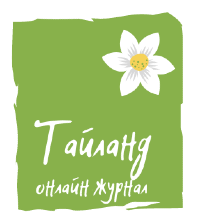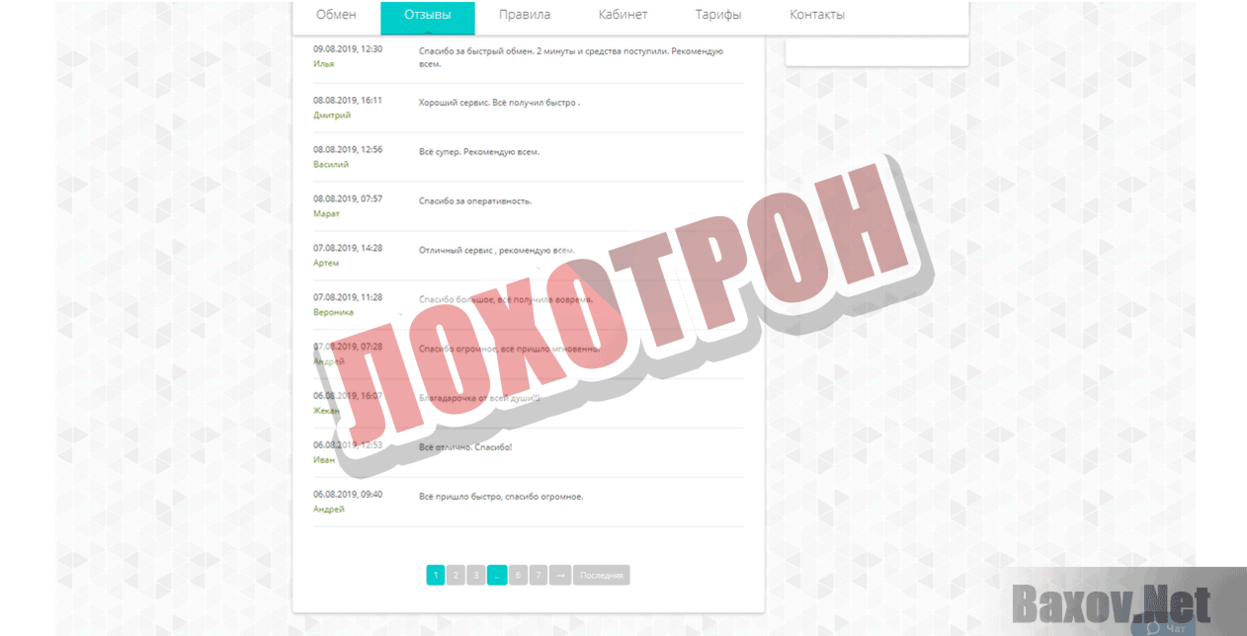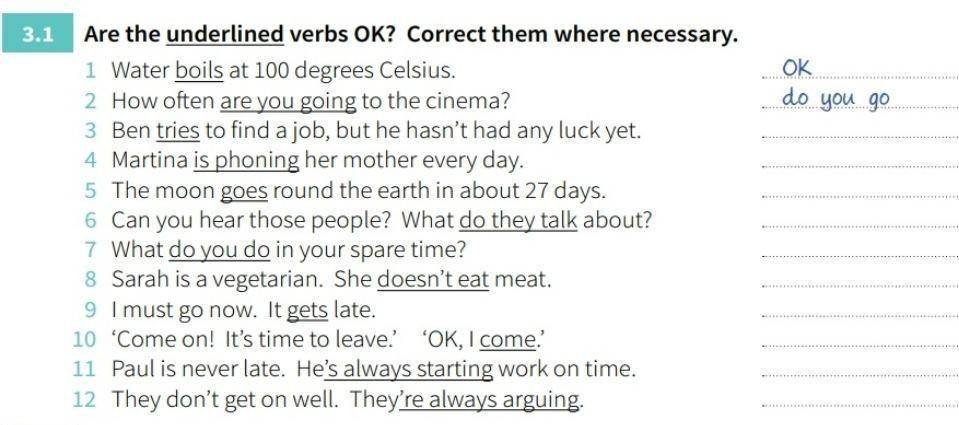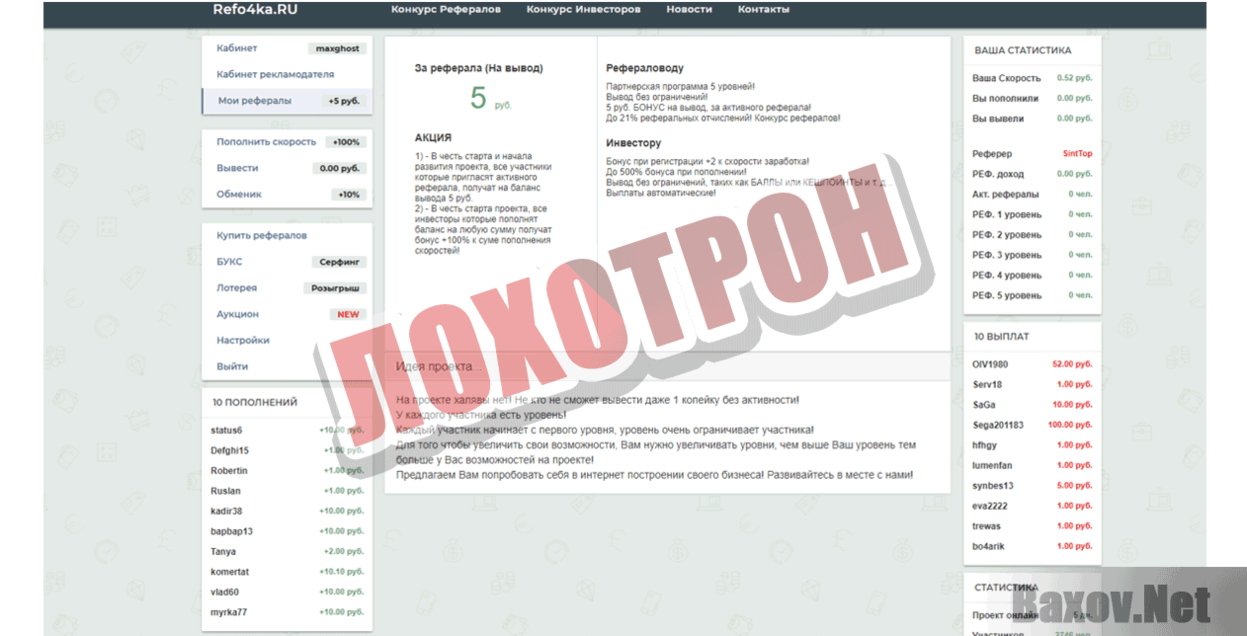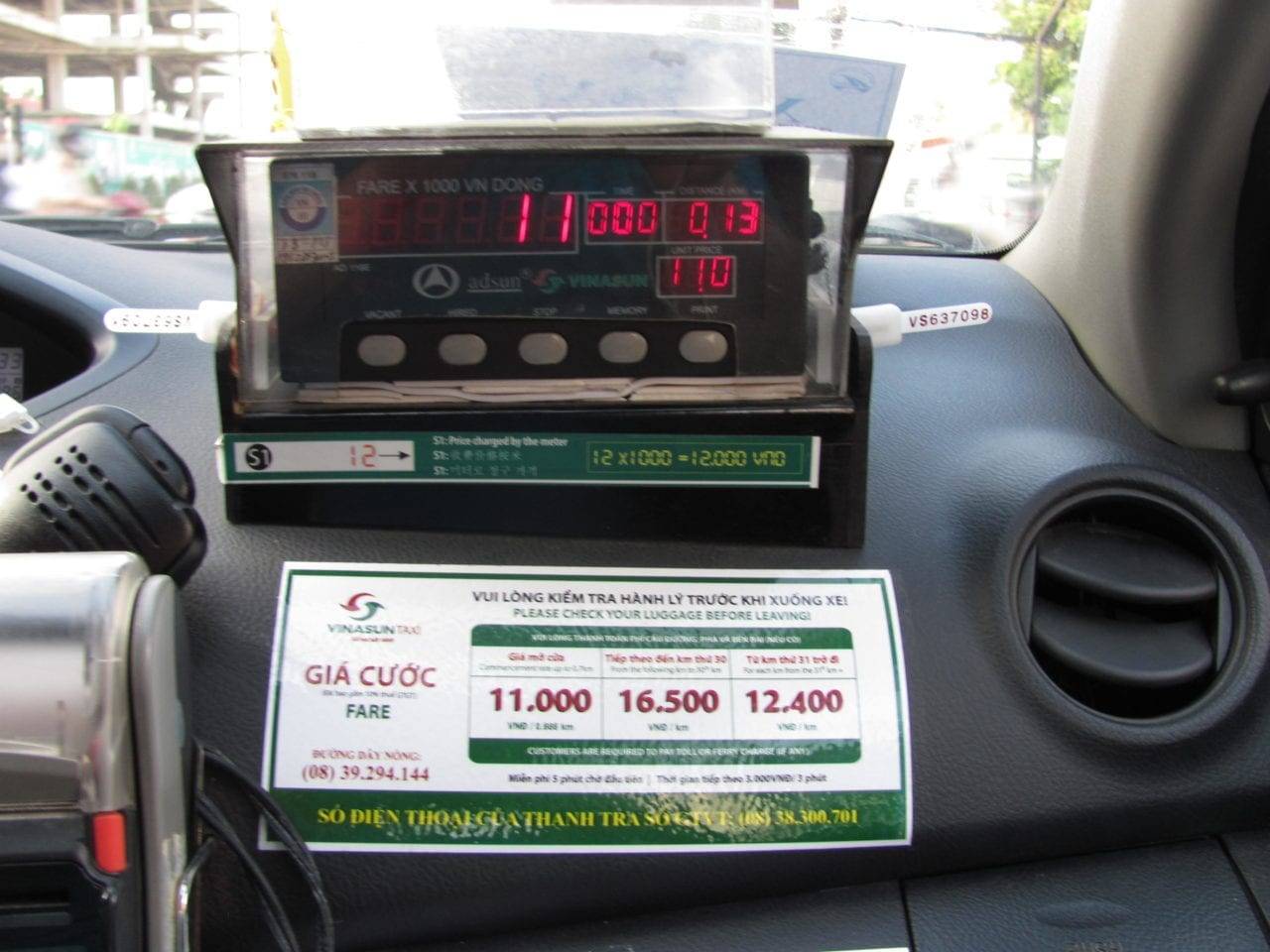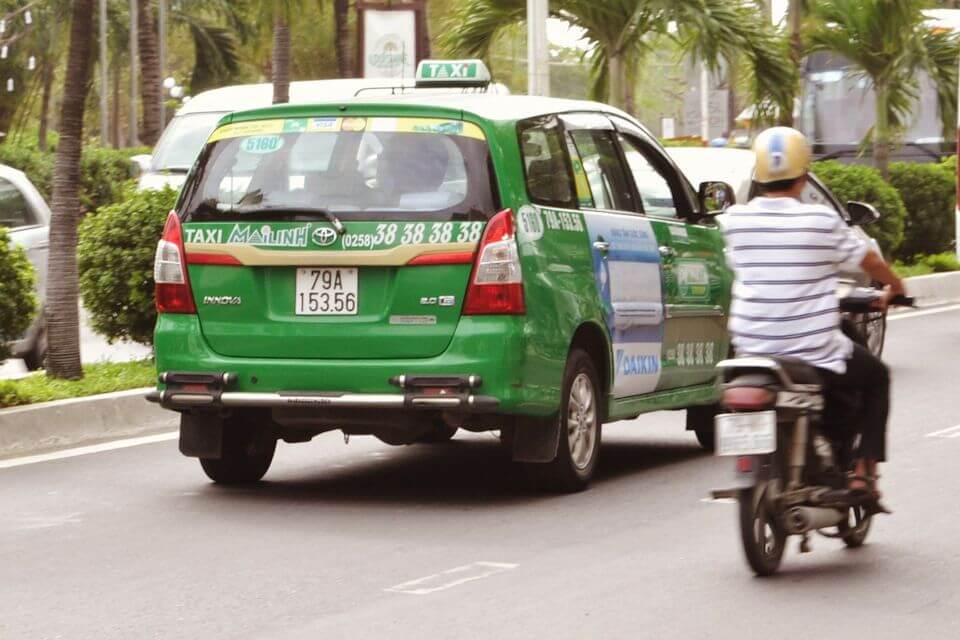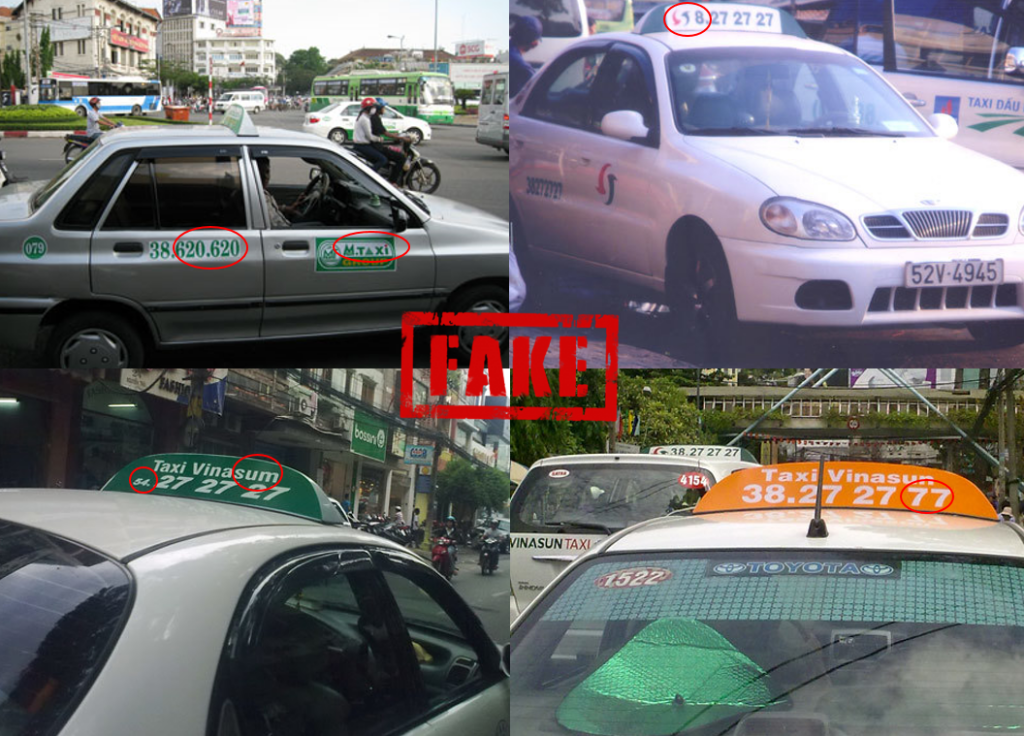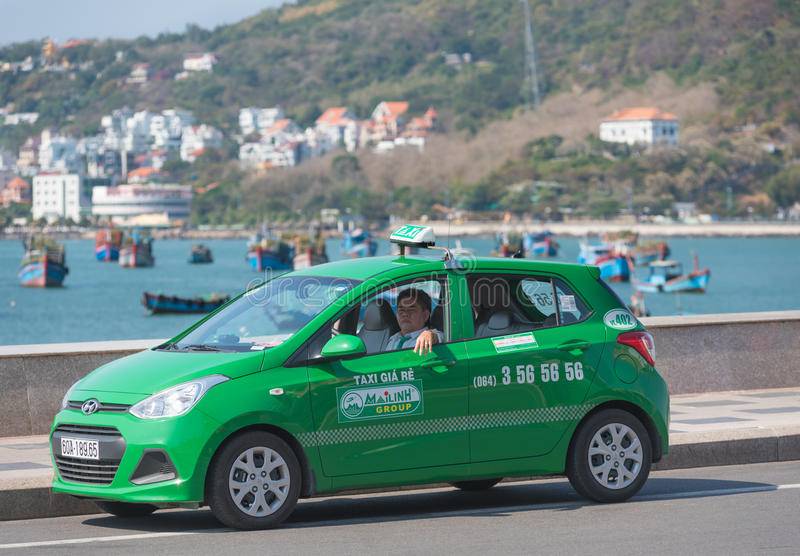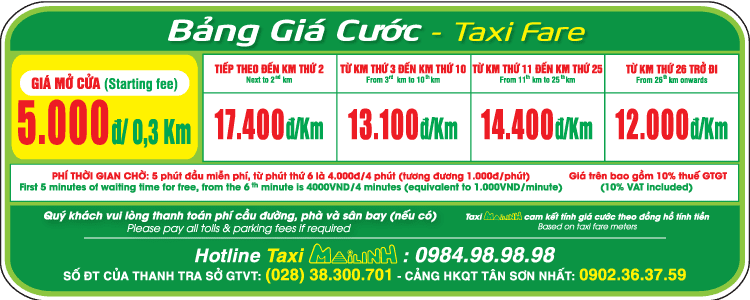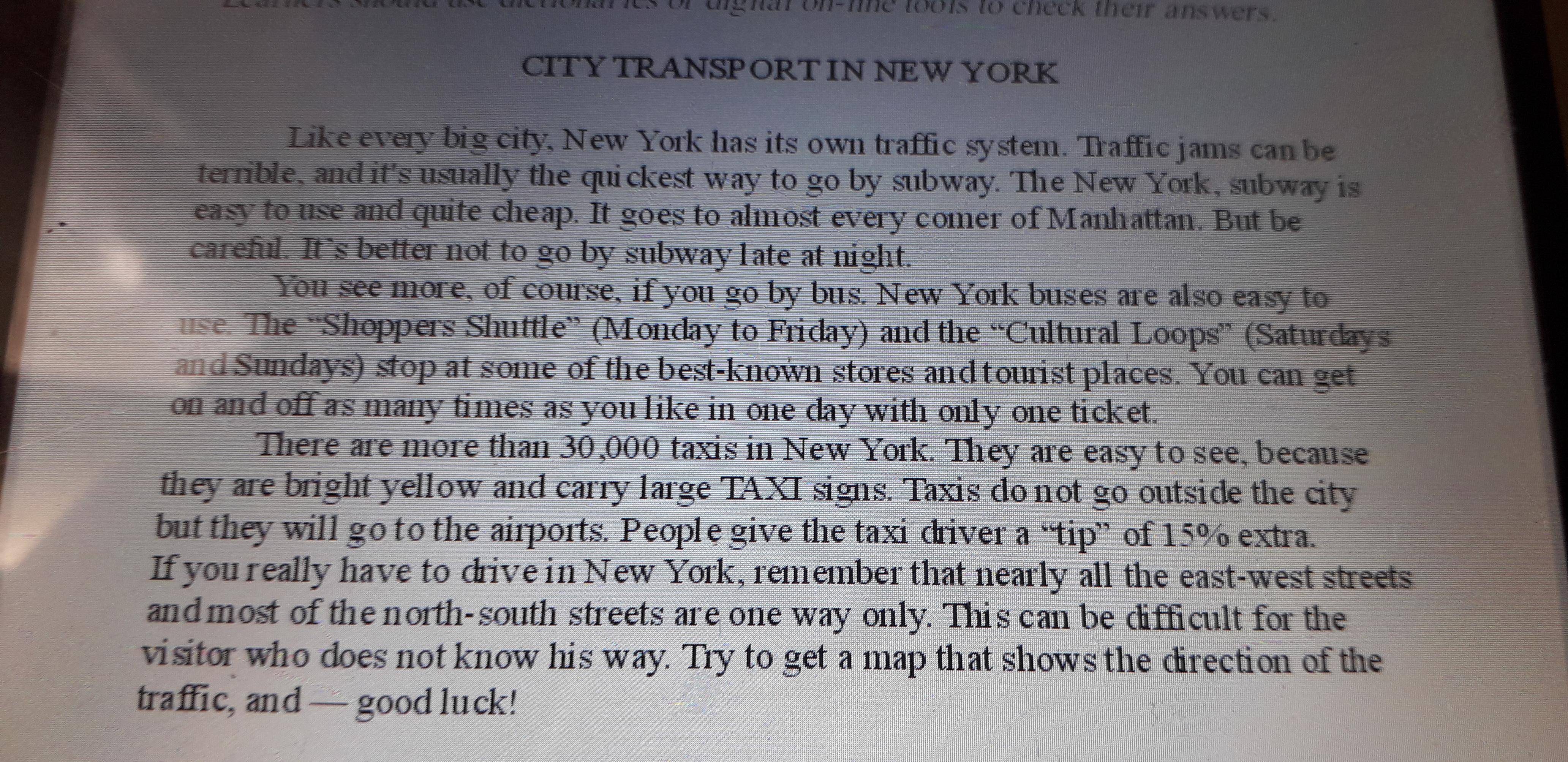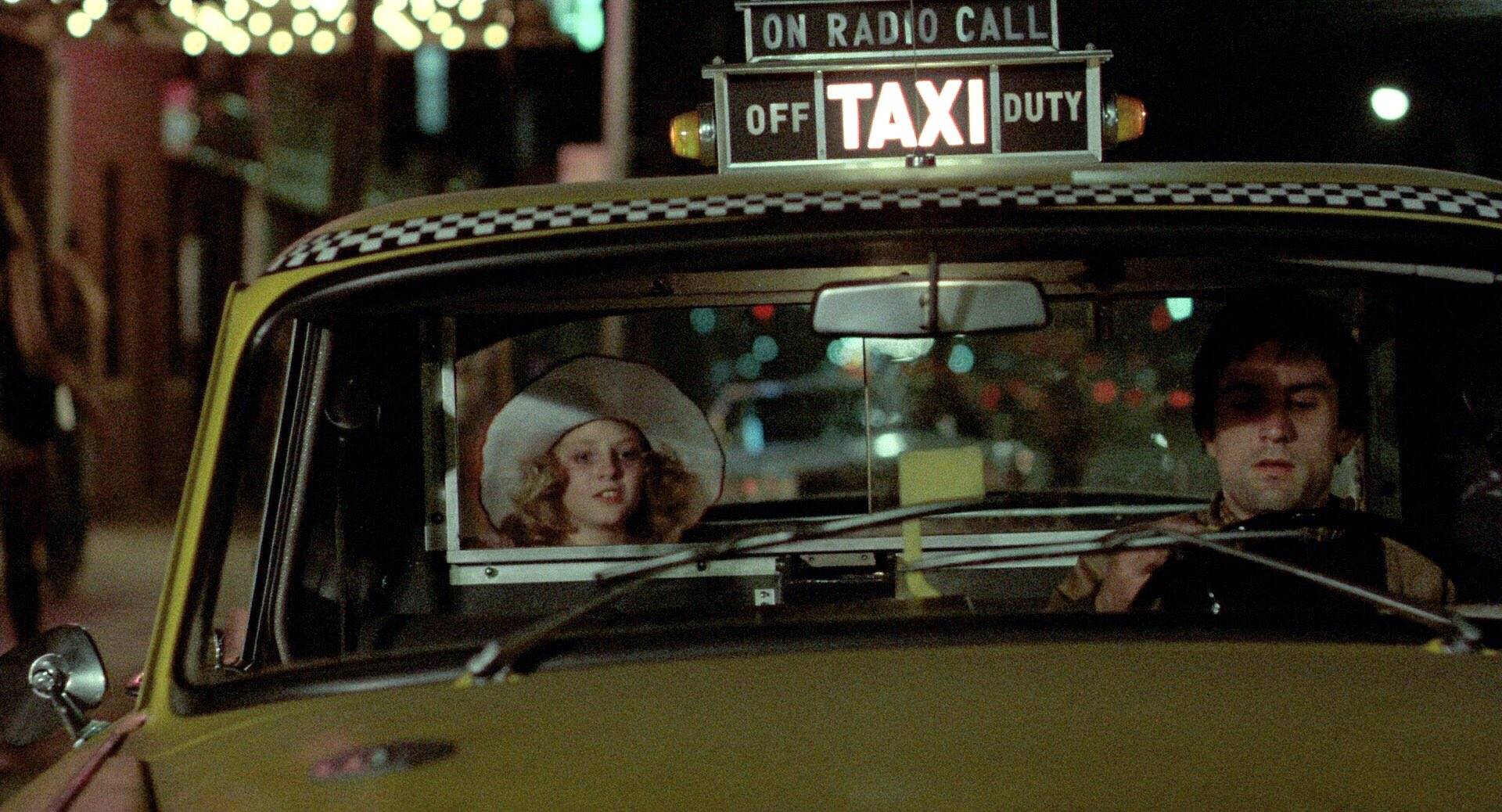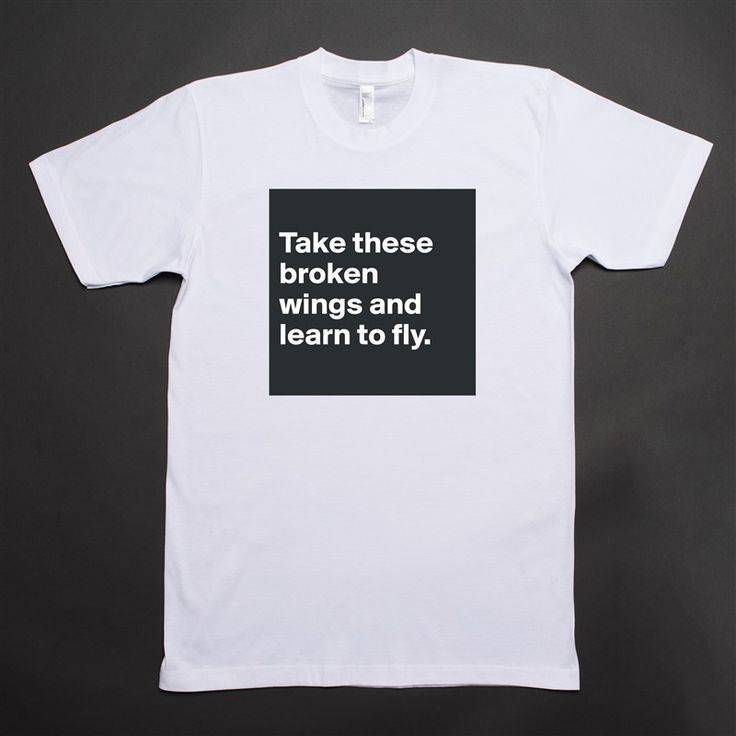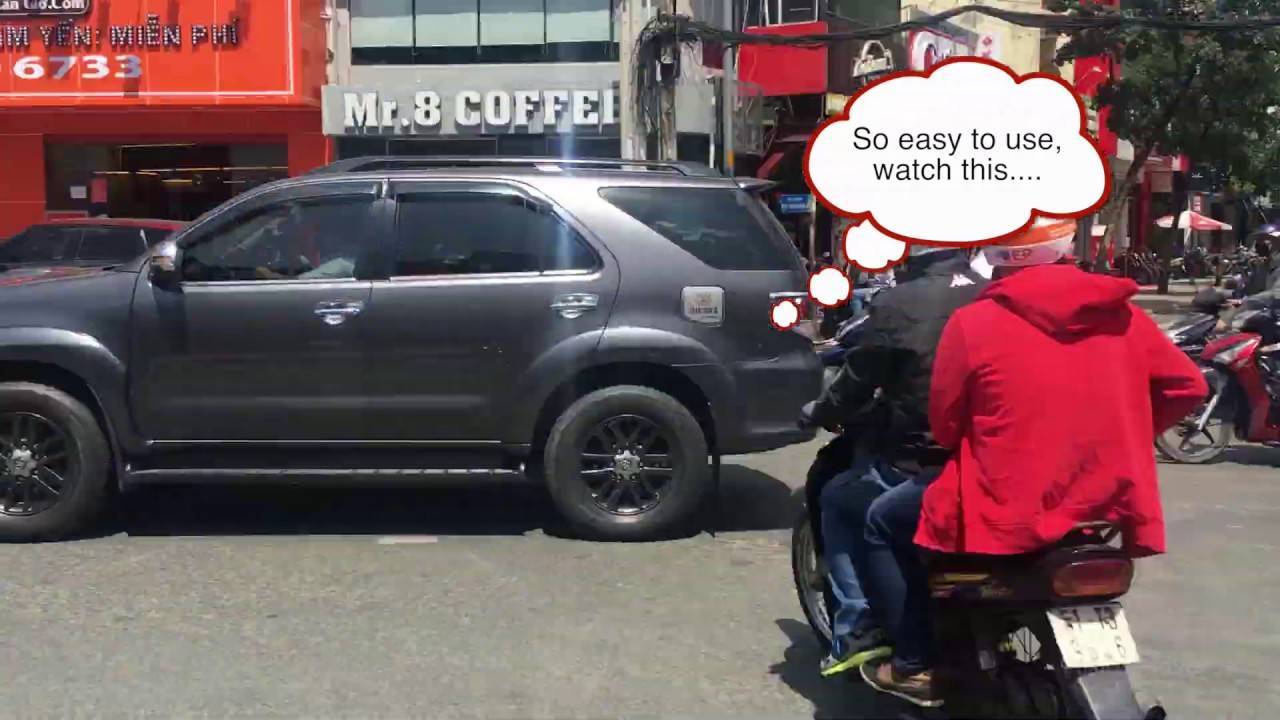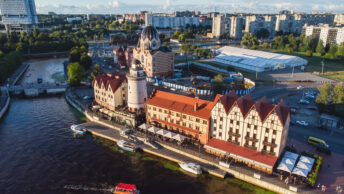How does Grab work?
To use Grab, we recommend having a Vietnamese 3G / 4G SIM card; View our detailed blog about how you can buy a sim card in Vietnam.
Step 1: Download the Grab app (Android | Apple) and create an account. Use the code: “GRABPHUOTVIVU” to get your first ride for free.
Step 2: Then choose the collection point and delivery point. After booking the ride, the driver often asks you to confirm, if the driver does not speak English, you can send him a message via the app, which often understands a simple English text.
Step 3: In the app you can see how far the driver is from you. You can also see his license plate, type of car and sometimes also the color. With this information it is easy to recognize the driver among all the other traffic. The motorcycle taxi is easily recognizable by its green helmet and jacket.
Step 4: If he takes you to the agreed location, you pay the driver the price that the Grab app has determined. If you store your credit card details in the app, you also have the option to pay with a credit card. When booking the taxi you can select how you want to pay.
Being prepared and Organised will save you a lot of hassle
There are two extremes of travel. At one end you have the people who put no effort into their planning and with a tiny backpack head off into the unknown, winging it, playing it by ear and just seeing where the wind takes them.
At the other extreme are the people who join complete tours where everything is planned for you, your itinerary is outlined and the company will have a good working relationship everywhere you go so the wheels are greased. This sort of travel is smooth and easy.
To be honest, we’re somewhere in the middle. I do pre plan, I research and I read so we don’t generally have a lot of problems, but it does happen occasionally that we make a mistake or someone else is just ”better” than us and we come out worse off. We dust ourselves off, learn from it and add it to our survival toolbox.
If this sounds like you and you want to maintain flexible travel while having some sort of organisation and control of your planning, here are some resources for you.
Travel resources we recommend
You can never go past a good Lonely Planet Vietnam (Country Guide) . With some great recommendations and general tips and advice it’s always good to have on hand. I often use it in the early stages of planning and then throw it in the backpack in case I need it while we’re on the road.
One thing we always do is book our hotel before arriving in a new place. We normally buy a sim card, and so while we’re on the bus on our way there, I’ll start searching for somewhere to stay.
Why? Because it’s a lot easier to negotiate a price or find a taxi to take you somewhere when you know where you’re going! Being vague or unsure leaves you open to being ripped off, and after a potentially long bus ride, I’m never interested in that.
We always use Booking.com. I like the way their website works and you can search filtering by both price and reviews so you can clearly see the quality and price side by side.
To get between cities, we use 12Go Asia. It’s a great resource that allows you to quickly and easily compare bus timetables and book your seats online.
Exposure during pregnancy
Note that this information is not new. All of the following comes from Section 8.3 of Pfizer’s own Phase 1/2/3 clinical trial data and literature, with some of said trials ongoing through 2023 and later. Those who love and yearn these shots will default to the “this information is being misinterpreted” defense. So we’re going to define the relevant terms involved herein.
- AE = adverse effect
- SAE = severe adverse effect
- Study intervention = A process or action that is the focus of a clinical study. Interventions include drugs, medical devices, procedures, vaccines, and other products that are either investigational or already available. The intervention group is the people who receive the experimental drug. In this case, experimental mRNA shots.
We start with Section 8.3.5.1 Exposure During Pregnancy (EDP) of the (page 62). The focus is on the last three bullet points.
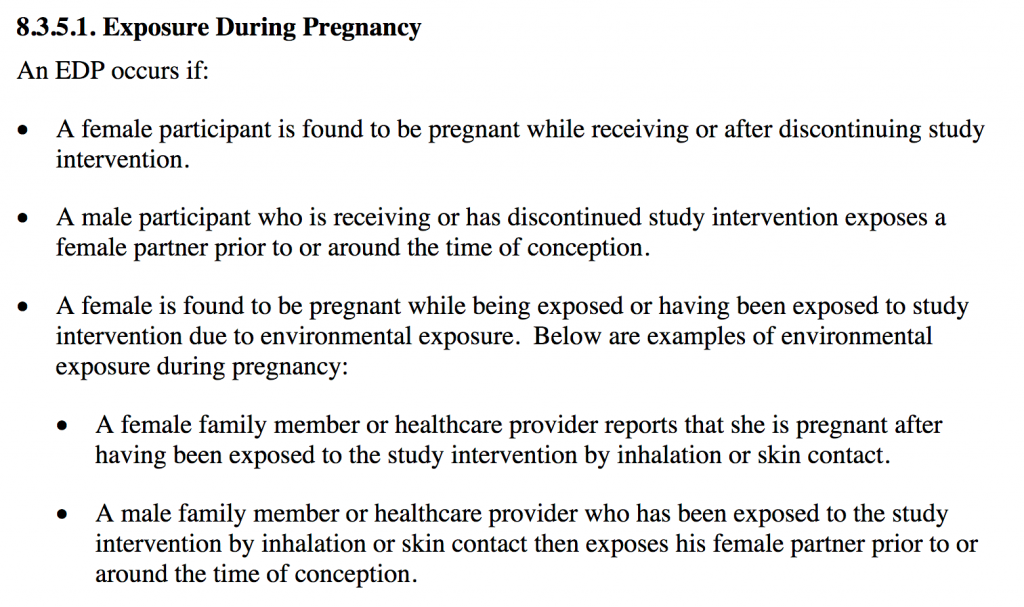
The Pfizer data clearly state that a pregnant woman can be exposed to the “study intervention due to environmental exposure.” Environmental exposure can happen through “inhalation or skin contact.” This is clearly saying that any contact, including sexual contact with someone who has received the shots, exposes those who have not received the shots to the “intervention,” the synthetic mRNA or DNA.
How to Hail a Taxi in Ho Chi Minh City
Walking in Ho Chi Minh City is not popular, as the sidewalk infrastructure here is a mess. It can be an intimidating experience when you try to walk in this city. No worries, the taxis are here to help you get around.
Hail a taxi using our tips so that you travel safely in Ho Chi Minh City.
Lucky for everyone, there are usually taxi’s everywhere in Ho Chi Minh City. Specifically talking about the two brands we have mentioned above. It won’t take long to get a taxi if you stand on the street waving one down for a ride. The exception to this rule is during rain and rush hour. When hailing a taxi at these times, you can expect to wait if you don’t get lucky in the first few minutes.
Raise your hand to get the taxi driver’s attention. While they may understand your signal, you don’t have to yell “Taxi!” or whistle like in Western culture. If you can whistle loudly, I recommend you do that because you will just look cool.
When the taxi driver arrives, the next step is just telling them your destination.
Though drivers these days are trained to speak English, there are still elderly drivers who don’t. Thus, you’ll need to carry a phone with you to show them the address, or write down the address on a piece of paper. A screenshot of the location is also very helpful.
Private Health Clinics : Best Solution for Expat
Fortunately, the quality of care in Vietnam’s private hospitals is acceptable and more or less meets what expatriates expect from a hospital. Private hospitals in major Vietnamese cities have the advantage of having doctors and health professionals in their staff who have studied in foreign countries such as the United States, Korea, Japan and France. This means that they are mostly bilingual or trilingual with a good understanding of English, French, Korean and even sometimes Japanese.

In addition, most of the basic treatments that are given in Vietnam’s private health facilities are covered by the international health insurance policy. Since the services of specialized health professionals can be quite expensive, it is preferable for expatriates to claim their health insurance. Generally, it is the services of dentists and dermatologists that are most in demand. However, it should be noted that although the rates applied to expatriates are significantly higher than those applied to locals, the cost of care in Vietnam is still lower than in other Asian countries. To this end, it is essential that all expatriates in Vietnam invest in comprehensive international health insurance to cover the high costs associated with private health care.
Best Private Clinics in Ho Chi Minh City Tailored for Expat
There is a wide choice of clinics in Ho Chi Minh city if you are looking for a private quality establishment whose staff will be there to listen, quality consultations as well as modern equipment if you have scanners, radios or other specific requests:
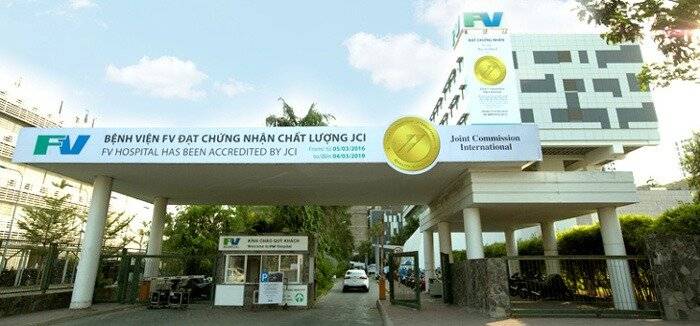
- FV Hospital: a renowned French-Vietnamese hospital in District 7, often tops the rankings of the best hospitals in Saigon
- International Medical Centre (CMI): French-Vietnamese hospital, doctors speak French and its location in district 3 is advantageous if you do not wish to travel to district 7
- Victoria healthcare in Phu Nhuan, District 1 and District 7 have doctors trained in the United States
Best private hospitals in Hanoi
Both Hanoi and Ho Chi Minh have many health clinics created with foreign investment. Doctors have generally been trained abroad, which guarantees that you can communicate in your native language (the French hospital in Hanoi has a very good reputation) and thus be reassured if you go there for delicate cases:
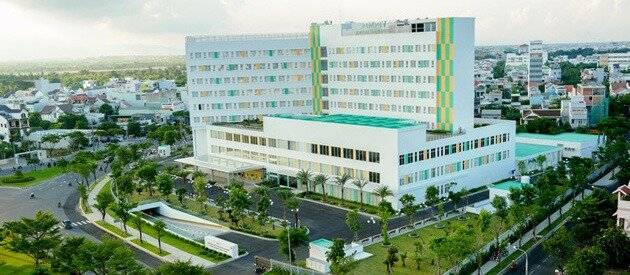
- Vinmec International General Hospital: Vinmec is well known as the one present in Ho Chi Minh, it is a modern hospital with an infrastructure, doctors and know-how that is well proven.
- Hanoi French Hospital (HFH): French private clinic originally created by the French. It always has a very good press and many French expatriates go there for their current or emergency health care.
- Japanese International Eye Hospital (JIEH): Private hospital from Japanese investments is one of the best choices for you if you are looking for an international clinic with proven expertise
What do you do when lost your wallet/luggage/phone on the taxi?
First, contact the taxi customer service immediately and report what you’ve lost. Before calling, you should make sure that you can provide as much information as possible, including the taxi identification number, driver’s name, departure and arrival points, total fare, and the route that was taken.
If you forget your phone, you shouldn’t call your number. In case there are some drivers or passengers who may want to keep it for themselves. Instead, allow the operator to find the taxi you’ve taken and have it sent back to the office.
To conclude, traveling via taxis in Vietnam is easy. Follow these instructions, you have the best chance to enjoy your trip without being a victim of any fake taxis or scams. Just like in life, nothing is a guarantee but we believe that this advice will help every traveler in Vietnam.
How do you get a visa for Vietnam?
Vietnam has a slightly more complicated visa system than the other countries in Southeast Asia. The requirements vary depending on which passport you hold, how long you want to stay, where you’re arriving, and whether you need multiple entry or not.
 This is what the Vietnam e visa official website looks like. Don’t get fooled by fakes.
This is what the Vietnam e visa official website looks like. Don’t get fooled by fakes.
Almost everyone will need to start by getting a visa letter from an online visa agency before you arrive in Vietnam. Bring your letter with you to the airport or land border and apply for your visa when you arrive.
Need your visa?Our quick and easy guide to Vietnam visas will get your sorted in minutes, no matter what passport you have.
How to buy a health insurance in Vietnam?
In addition to taking out an insurance policy once on site, it is also possible to make comparisons on the Internet in order to find an insurance company that offers international health insurance adapted to everyone’s needs. Generally, many expatriates opt for companies that handle all the administrative.
Our recommendation: best health insurance in Vietnam ?
If you are looking for a legit health insurance dedicated to expats or fitting the requirements to enter Vietnam for travel purpose, you can fill out this form to get a fast and free quotation and compare the different rates:
Which benefits do you want ?
Do you have any specific requirements ? Did you already received medical advice or treatment before ?
Your information will be kept private and mandatory to provide you a personalized quotation.
General
Benefits
Budget
Requirements
Details
VietnamCambodiaThailandLaosMalaysiaMyanmarPhilippines
Benefits
Insurance coverage
Travel (best-choice for a short trip)InpatientInpatient + OutpatientInpatient + Outpatient + Dental
️ If you come to Vietnam for a short stay (as a tourist), select the first choice “Travel”. If, on the other hand, you are looking for long-term insurance for expats, then choose the other options.
The difference between an inpatient and outpatient care is how long a patient must remain in the facility where they have the procedure done. Inpatient care requires overnight hospitalisation while outpatient don’t need to spend a single night in a hospital.
Cheapest optionBest value / price ratioHigh Quality
How many people do you want to insure ?
Only me23More than 3
SHOW SUMMARY
Submit
Previous Step
Next Step
FAQ : Answers of the most asked questions in 2022 from forums and Facebook groups
️ Full refunds for treatment costs
Because of the situation in Vietnam, hospitals are no longer refund health-check and treatment fees for tourists and expatriates who are not resident in Vietnam (they must have a work permit). So being insured for any medical expenses becomes mandatory for tourists and expats in Vietnam.
International vs local health insurance
Being covered if you are doing trips in South East Asia is a must. This is one of the criteria of our study to find the best health insurance in 2022 for south east asian expats or tourists : fit the needs who plan to live a couple of months or years in Asia.
Being covered if you are doing trips in South East Asia is a must. We have taken this parameter into account and we can recommend the best health insurance in 2022 for expats or tourists in South East Asia. You will fully meet the needs and requirements for Vietnam and you will also be insured for your travels in ASEAN countries.
Cost of health insurance in Vietnam
The starting average package is about 60$/month for an inpatient policy to be secure if you are seriously sick (inpatient). For this rate, you will have to pay for your own health check-up, dentist, … Outpatient options are also available to get a higher health package. Submit your request for a free quote by to get the best offer fitting your situation.
Vietnam health insurance law 2019
Vietnam is currently implementing a global health care system to cover all the population. Local companies must fit the new requirements and get a health coverage for their staff. Finding a local healthcare partner is now one of the biggest challenge human ressources of vietnamese companies are working on in 2019 and 2020.
Those who have knowledge of the insurance world can choose according to a few criteria instead of just the folds that are offered :
Survival tips for the tougher times
 Many of the temples in Vietnam are same same, every now and then you find one that is spectacular. This is a photo from Bai Dinh temple in Ninh Binh
Many of the temples in Vietnam are same same, every now and then you find one that is spectacular. This is a photo from Bai Dinh temple in Ninh Binh
Try not to take it personally. Its not about you at all, its about their personal situation.
Recognise that not everyone who charges you a tiny bit extra is a scammer. If you choose to feel scammed every time you pay 10000 VDN more than a local you are going to have a very difficult time. Obviously the amount extra should be relative to the actual cost!
Learn the lesson when you are legitimately scammed and do not make the same mistake again.
Understand that sometimes, you can do all the right things but still end up on the wrong end of the deal. Unless you have a means of recourse your best bet is to let it go. Chalk it up to experience. If you carry your frustration forward you’ll only impact your own experience.
Be Wary Of Fake Taxis
Now, you may have heard that the 2 most reliable taxi
companies in Vietnam is Vinasun and Mai Linh.
Yet the thing is, although the drivers may work for a
reputable taxi company, remember this… each driver is an individual!
Now, there are other taxi companies that we’ve used that we’ve
found reliable… but these companies may be regional like just in Nha Trang.
Here is a photo of an example of a Vinasun taxi…
The Vinasun taxis are generally white with a one red strip and green strip below. Here is a link to their website. So then you can find out what the phone number should be on the side of the taxi, as a guide for if it’s a genuine Vinasun taxi.
And here’s a photo of an example of a Mai Linh taxi. Generally Mai Linh taxis are green, but they can also be white like in this example.
Here’s their website for more information… and to check the phone numbers for the different regions in Vietnam
What you may find is that others may try to make their branding and details similar to these 2 taxi companies. So make sure you familiarize yourself BEFORE getting into a taxi, as it may be a fake taxi.
Best time to go to Vietnam
You can’t go to Vietnam expecting the weather conditions to be ‘perfect’ if you’re going to travel all of it.
There’s no way getting around the fact that the climate is just very different in the north, center, and south, which are very geographically separated.
While much of the country is tropical, keep in mind the north is in a temperate zone. Expect the mountainous north to be a little cold in winter. Even in autumn or spring it can be a bit cold at night. Pack a hoodie, and maybe a jacket for winter. If you’re going in summer, expect it to be very hot and humid.
The north also tends to be quite cloudy and misty for much of the year (because of both weather and smog). The best chance of clear skies in Halong Bay is in April to June, and September/October.
For central and south Vietnam, the wet season is something to keep in mind. For central Vietnam (e.g. Hoi An, Hue, Da Nang) this is in October / November. In the south (e.g. Ho Chi Minh City) it’s May until October.
How to book a car with DiDi
The typical situation is: I have to take a train or flight or I arrive at the airport – even at unfortunate times. No problem: choose which category of car you want to use and click on “reserve”.
With this function you can change the date and time of your ride. If you opt for a Premier, there’s already an airport option from the list on the menu, including the flight number in case the driver has to come get you upon arrival. Or enter the destination that you’re interested in and reserve.
Drivers like to give you a call to confirm, especially if you go to the airport or are waiting for a long drive. Now you know…
In addition, you have the chance to use all of DiDi’s functions, even for a friend, changing the passenger name: click on “for others” or “change passenger”. Fill out the required data and the charge will be made on your phone.
Use The Grab Vietnam App
Grab is a transport company, where via an app you can book
rides like a taxi service. Plus, in Vietnam for example… with Grab you can get
food delivered, parcels delivered, pay bills and more.
With the Grab app, you’ll know what the general fare is
before you ride. So then you have an idea of what you’d expect to pay. Be wary
that the fare does not include fees like tolls.
Generally though with tolls, you can see what the toll
amount is. That’s because the Grab driver will need to stop at the toll gate. Then
the fee to be paid is displayed, and the driver pays the fee in cash. You then
pay the driver back.
Also, as the fare is fixed apart from the tolls for example… the Grab driver will aim to get you to your destination as efficiently as possible. So there’s no point in trying to scam you.
Reliable Support If You Need It
And the great thing is, Grab have a support center where you
can make a complaint about your driver or the ride. They have support in
English too.
I’ve had to use this a few times and found the support to be
excellent. Also, if they find that the driver is in the wrong, they will give
you compensation in the form of a credit on the Grab app. You can then use that
credit on a future trip.
Plus, you earn points for every ride you take. So, if you
take enough Grab rides you could redeem your points for food, ride discounts or
more.
And another good thing about Grab is that you can see the
ratings of the driver BEFORE you take the ride. So, if the driver is not a 5
out of 5 star rated driver you can cancel the ride.
Generally, the fare will be cheaper than a taxi too.
Using Grab Vietnam is our preferred method of travel… rather than being caught in the middle of a Vietnam taxi scam. Yet, on occasions we’ve had to hail a taxi. But we can use the Grab app as a taxi fare estimator too.
So, hopefully all this information will help you to avoid or
get your way out of a Vietnam taxi scam.
Enjoy your travels, especially if you don’t travel often.
Yet as mentioned earlier… make sure you’re cautious and aware of your
surroundings to help avoid tourist scams.
Have you been involved in a taxi driver scam? Let us know what happened and what you did to resolve it!
Should you go to Vietnam?
Yes! Absolutely.
Vietnam is such a diverse place, with everything from spectacular beaches like those on Phu Quoc Island, beautiful karst limestone mountains such as those in Tam Coc, Ancient world heritage towns such as Hoi An, desert like sand dunes in Mui Ne and spectacular caves in Phong Nha, theres something for everyone.
If you’re planning a trip to Vietnam I hope this post helps prepare you and quash any concerns you might have. We’ve also put together a complete guide of Vietnam travel tips with everything you need to know before you go.
Feel free to ask any questions if you have any concerns we haven’t addressed here.
This article contains affiliate links. For more information, please see our affiliate disclaimer here.
Like it? Pin It!
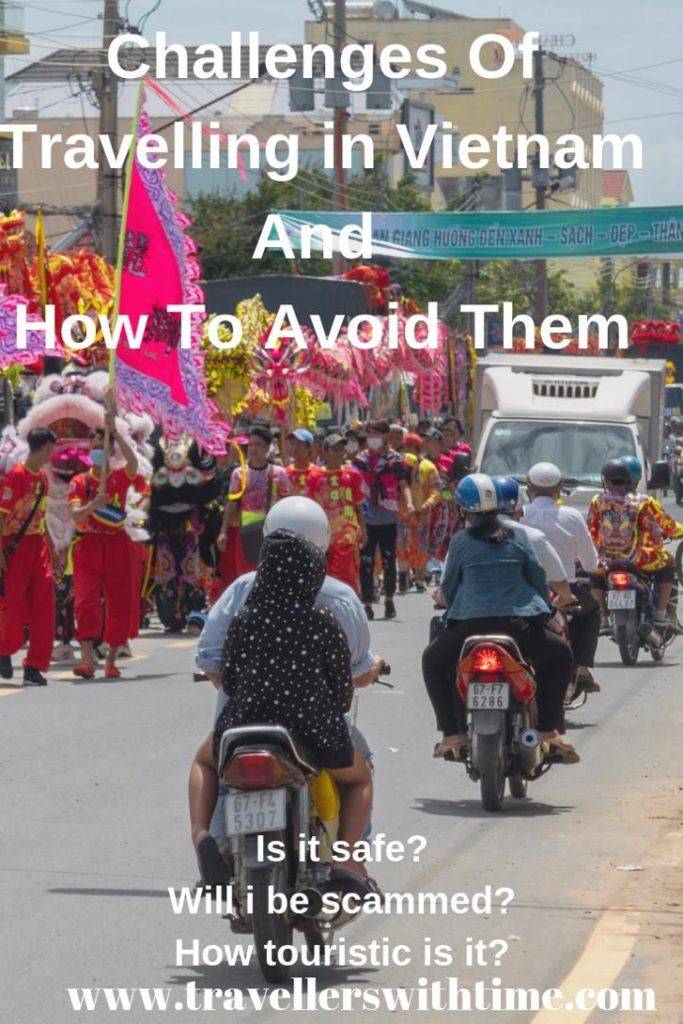
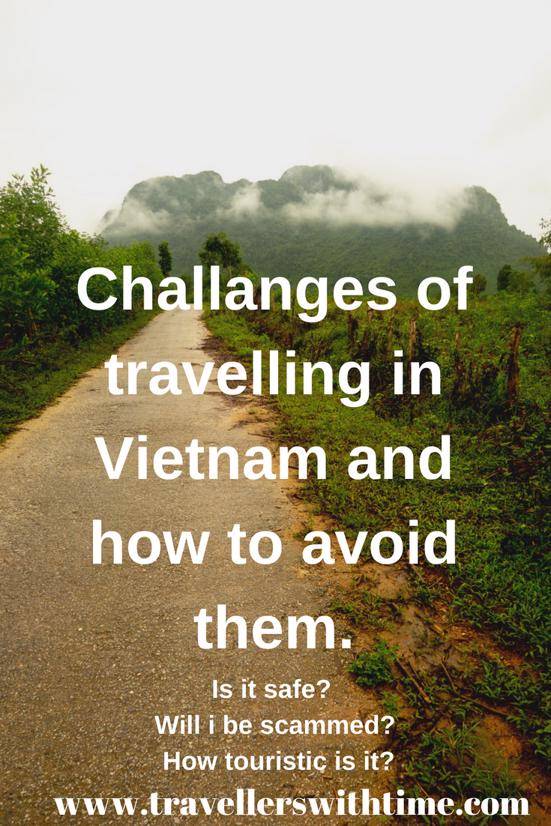
Food in Vietnam

Vietnamese food is simply amazing. But you’d be wrong to assume it’s only about pho noodle soup or spring rolls! Yes, these are things you may already be familiar with from Vietnamese restaurants, but there is a whole other world of Vietnamese food to taste.
I’ve noticed that many backpackers end up ordering only bland or generic ‘chicken stir fry’ or ‘noodle soups’ from tourist menus. There’s nothing wrong with these per see, but there’s loads of other delicious stuff to try in Vietnam.
Parts of the country also have their own specialities. One of the best things you can in Vietnam is to take a guided street food tour in Saigon or Hanoi, as this will give you an incredible crash course in all that’s there on offer. You might also want to check out our very own guide to the best Vietnamese street food.
Backpacking Vietnam: my impressions
I had a great time on both my journeys through Vietnam. The first in 2013 offered a great introduction to Vietnam, though as a less experienced traveler I did face various challenges. It was this trip that I was probably scammed the most I have ever been, including by a taxi driver trying to charge $80 worth of dong for a 5-minute trip (and getting aggressive when I refused), a restaurant switching their menu for another one with much higher prices, and many other such shenanigans. As a result, Vietnam felt less welcoming.
I had no such difficulties at all on my second trip in 2019; in fact, I discovered how kind and welcoming the Vietnamese truly are. Maybe I knew better how to avoid such annoyances, or it’s possible Vietnam has simply chilled out a lot more in recent years now that its economy is booming. Technology has helped too: if you use apps like Grab, drivers will not be able to overcharge you. There are some older blog posts out there complaining about Vietnam but I think this may be a different Vietnam from the past.
All in all, I believe Vietnam is one of the most exciting destinations in Asia, especially from a cultural, culinary, and adventure point of view. It maybe doesn’t have the best beaches, but backpacking in Vietnam is about so many other things than that.
Consider places not yet touched by mass tourism like Ha Giang region, Phong-Nha, and the beaches around Qui Nhon. Or go on a homestay in Sapa, visit the national parks, embrace the chaos of Hanoi, or go on a motorbiking trip through rural Vietnam. They’re some of the best experiences you can have in all of Asia.
What is the difference between Taxi and Express
Taxi cars are generally much more rickety and less clean than those of private cars; but taxi drivers are great experts on traffic, so if you don’t fear the fictional Chinese driver but you need to swiftly reach your destination, I recommend a taxi.
This is also because DiDi drivers tend to stick to the route suggested by the DiDi navigator, even when these are jammed with traffic or less convenient, whereas a taxi driver will more easily take you on an alternate road.
An annoying detail that I noted when taking taxis and Express is that often these vehicles hide the seat belts in the back seats behind the seats themselves, or under the seat covers, or that they’re so old that they’re useless. Traveling often with my daughter, it’s been a problem for me: in fact in China car seats are not obligatory and you won’t find one available, even when booking the car in advance. A seat belt therefore remains the only form of security for babies.
The Chinese usually prefer to travel with Express or even ExpressPoll because they can save a little bit. But all things considered, for long trips, choosing a Premiere is maybe just another 5 € more for a service and driver that is much better.
Other Tipping Tips
- Make sure you’re familiar with Vietnamese currency. As mentioned earlier, Vietnamese money can be a little confusing, as lots of the notes look pretty similar – and there are no coins in the nation. So ensure you’re familiar with the currency to make sure you’re tipping what you want to tip (and paying what you want to pay).
- Vietnam is a cash currency. In some hotels, hostels, supermarkets and high-end places, you can pay by card, but the vast majority of transactions are in cash. Always carry lots of cash. All tips you leave will be in cash.
- If you’re on a tight budget, don’t worry if you can’t leave a tip. It’s of course a nice gesture, but tipping isn’t expected in Vietnam like it is in many other countries.
- Though some expensive establishments in Vietnam will accept US dollars, they’re not commonly accepted. So if you’re tipping a particular person, always tip them in local currency, not in US dollars. The person you’re tipping won’t have much use for them.
- In remote, rural areas, don’t be surprised if people are embarrassed by your offer of a tip. If people in these areas seem reluctant to take your tip, don’t be afraid to take it back. Sincere thank you might be more appropriate in these areas.
- Generally, just follow your instincts on tipping. If you want to give a tip, just give a tip! People in Vietnam don’t generally earn very much money, so it’s good to be generous. And since Vietnamese people are brilliant, it’s nice to repay their warmth, generosity and kindness with small tips where appropriate.
3 Weeks in Vietnam Itinerary
Looking for more Vietnam Itineraries?
If you don’t quite have one month to spend, then the above itinerary can be adapted to a 3 week Vietnam Itinerary or even a 2 week. You would just need to spend less time in each place or miss out on a few of the stops mentioned above. Here’s what we’d recommend for the perfect 3-week travel route! (A few ideas on things to do below, see more advice above or in the individual travel guides…)
- Hanoi – 2 days (Soak up the city, go sightseeing, gorge on Vietnamese street food!)
- Halong Bay – 3 days (Spend 3 spectacular days in this UNESCO World Heritage site on a Halong Bay Tour.)
- Sapa – 2 days (Go trekking in Sapa amongst the lush green rice terraces and spend a night with the ethnic minority village.)
- Ninh Binh – 2 days (Explore ‘Halong Bay on Land’ independently or on a Ninh Binh Tour.)
- Phong Nha National Park – 3 days (Go hiking, swimming in rivers and explore some of the biggest caves on the planet!)
- Hue – 1 day (Go sightseeing in the historical city.)
- Hoi An – 3 days (Wander the colonial streets, take a Hoi An street food tour or visit An Bang Beach or the Cham Islands.)
- Dalat – 2 days (Enjoy the cooler temperatures and adventure activities in the ‘Alps of Vietnam’.)
- Mui Ne – 2 days (Relax on the beach or try surfing or kiteboarding in Vietnam’s water sports capital.)
- Ho Chi Minh City – 1 day (Enjoy the hectic pace of Vietnam’s largest cities.)
= 21 days in Vietnam!
